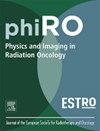Adaptive treatment margins to reduce organs at risk dose in patients with no or minimal anatomical changes in radiotherapy of non-small cell lung cancer
IF 3.4
Q2 ONCOLOGY
引用次数: 0
Abstract
Background and purpose
In non-small cell lung cancer (NSCLC) a significant portion of the planning target volume (PTV) margin accommodates for anatomical changes during treatment. Patients with no or minimal anatomical changes might therefore benefit from a reduced PTV margin, resulting in lower organ at risk (OAR) doses. We evaluated a plan of the day approach using different PTV margins to quantify its effect on OAR and clinical target volume (CTV) dose.
Materials and methods
Twenty NSCLC patients were included in this retrospective study. CBCTs of all fractions were evaluated using an image-guided radiotherapy (IGRT) protocol to classify fractions into two groups: no or minimal anatomical changes to which reduced PTV margin plans (5 or 2 mm) were assigned, or with anatomical changes that received the reference treatment plan (8 mm PTV margin). OAR doses were investigated and CTV coverage was evaluated using CBCT dose recalculations.
Results
All plans showed decreased OAR dose when the PTV margin was reduced from 8 mm to 5 mm or 2 mm. The IGRT protocol selected 254/600 fractions in 19/20 patients, that could be treated with a smaller margin. CTV V95% remained ≥95% in 94% of the 5 mm plans and 87% of the 2 mm plans, compared to 98% of the reference 8 mm plans.
Conclusion
The IGRT protocol could identify fractions with no or minimal anatomical changes allowing a plan of the day approach to reduce PTV margins. Target coverage remained adequate in the majority of patients, while reducing OAR doses.
在非小细胞肺癌放射治疗中,无解剖改变或解剖改变很小的患者的适应性治疗边缘以减少危险器官剂量
背景和目的在非小细胞肺癌(NSCLC)中,计划靶体积(PTV)边缘的很大一部分适应治疗期间的解剖变化。没有或只有微小解剖改变的患者可能因此受益于减少PTV边缘,从而降低器官危险(OAR)剂量。我们使用不同的PTV边界来评估一种每日计划方法,以量化其对OAR和临床靶体积(CTV)剂量的影响。材料与方法回顾性研究20例非小细胞肺癌患者。使用图像引导放射治疗(IGRT)方案评估所有分数的cbct,将分数分为两组:没有或只有很小的解剖变化,分配了缩小PTV边缘计划(5或2 mm),或有解剖变化,接受参考治疗计划(8 mm PTV边缘)。研究了OAR剂量,并使用CBCT剂量重新计算评估了CTV覆盖率。结果PTV切缘由8 mm减小至5 mm或2 mm时,所有方案均显示OAR剂量减小。IGRT方案在19/20例患者中选择了254/600个分数,可以以较小的边际进行治疗。与98%的参考8mm方案相比,94%的5mm方案和87%的2mm方案的CTV V95%保持≥95%。结论IGRT方案可以识别没有或很小的解剖改变的部分,允许计划一天的方法来减少PTV边缘。大多数患者的目标覆盖率仍然足够,同时减少了OAR剂量。
本文章由计算机程序翻译,如有差异,请以英文原文为准。
求助全文
约1分钟内获得全文
求助全文
来源期刊

Physics and Imaging in Radiation Oncology
Physics and Astronomy-Radiation
CiteScore
5.30
自引率
18.90%
发文量
93
审稿时长
6 weeks
 求助内容:
求助内容: 应助结果提醒方式:
应助结果提醒方式:


